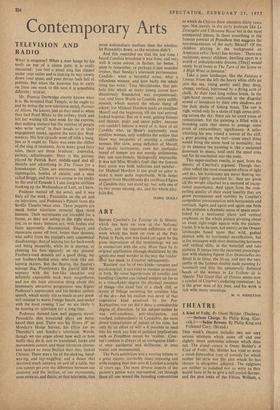BEFORE Courbct's La Toilette de la Markle, which has been
on view at the National Gallery, and the important exhibition of his work which has been on view at the Petit Palais in Paris, one was faced vet again by the gross imprecision of the terminology we use in connection with the arts. More than by its original application (though disclaimed by the a[tist) one must wond6r at the way the 'realist' Intl has stuck to Courbet subsequently.
'Realism' can he of two kinds—sensory and psychological: it can refer to manner or matter. or both. By some legerdemain of tonality and handling Courbet can indeed conjure up for us to a remarkable degree the physical presence of things--the exact feel of a chalk cliff, or layers of foliage screening the cerulean blue of the sky—but his realism was never of that acquisitive kind practised by the Pre- Raphaelites, nor yet did it deny a considerable degree of distortion. In his subject-matter he was anti-academic, anti-idealisation. and reached, independently of Constable, the most direct transcription of nature of his time, but only by an effort of will is it possible to read
to which de Chirico drew attention thirty years ago. Not merely in the early portraits like Le Desespere and L'Homme Blesse but in the most unexpected places. Is there something in the famous portrait of Proudhon that suggests the neo-romanticism of the early Berard? Of the children playing in the background an American critic (Soby) has written : 'There are malicious, unreal children, dwelling apart in a world of indecipherable dreams. [They] would surely he at home in The Turn of the Screw or A High Wind in Jamaica.'
Take a pure landscape, like the Falaises h Ltretat. From the left the heavy white cliffs jut into the sea, rising gently until they drop, abrupt, vertical, buttressed by a flying arch of chalk. At their foot long rollers break. In the right-hand corner, anchored to the diagonal strand of foreshore by their own shadows, are the dark shells of fishing boats. The sun is high, veiled only by a skein of high cirrus drift- ing across the sky; there are no overt tones of romanticism. Yet the painting is filled with a brooding calm that seems to presage some event of extraordinary significance. A sailot whistling his way round a corner of the cliff. a goat grazing on the turf—some small thing would bring the scene back to normality; but in its absence the painting is like a sustained dominant in music, held until the mind cries out for its resolution into the tonic.
This super-realism results, in part, from the density of Courbet's pigment. Though they often reflect the most evanescent effects of light and sky, his landscapes are never fleeting im- pressions lightly sketched in : they are given all the weight attached to a moment of excep- tional importance. And apart from the com- pelling quality of their exact tonality they are given permanence and stability by Courbet's compulsive preoccupation with horizontals and verticals. Again and again and again one finds in his pictures a dramatic sense of space estab- lished by a horizontal plane and vertical emphases, or the whole picture pivoting about an exact right-angle square with the picture- frame. It is to be seen. not merely in the Ornans landscapes based upon that wild, gashed plateau with its horizontal stratification, but in the seascapes with their dominating horizons and vertical cliffs, in the waterfall and lake pictures. It creeps into the recurrent preoccupa- tion with sleeping figures (Les Demoiselles des Bords le la Seine, the Siesta, and into the very centre of the famous double nude painting Le S'ommeil) and into the unnaturally flattened heads of the women in La Toilette de In Mariee. The Great Oak of Ornans seems now a symbol of Courbet's enduring reputation : he is the great man of his time, and his work is rich with many meanings.
M. H. MIDDLETON










































 Previous page
Previous page